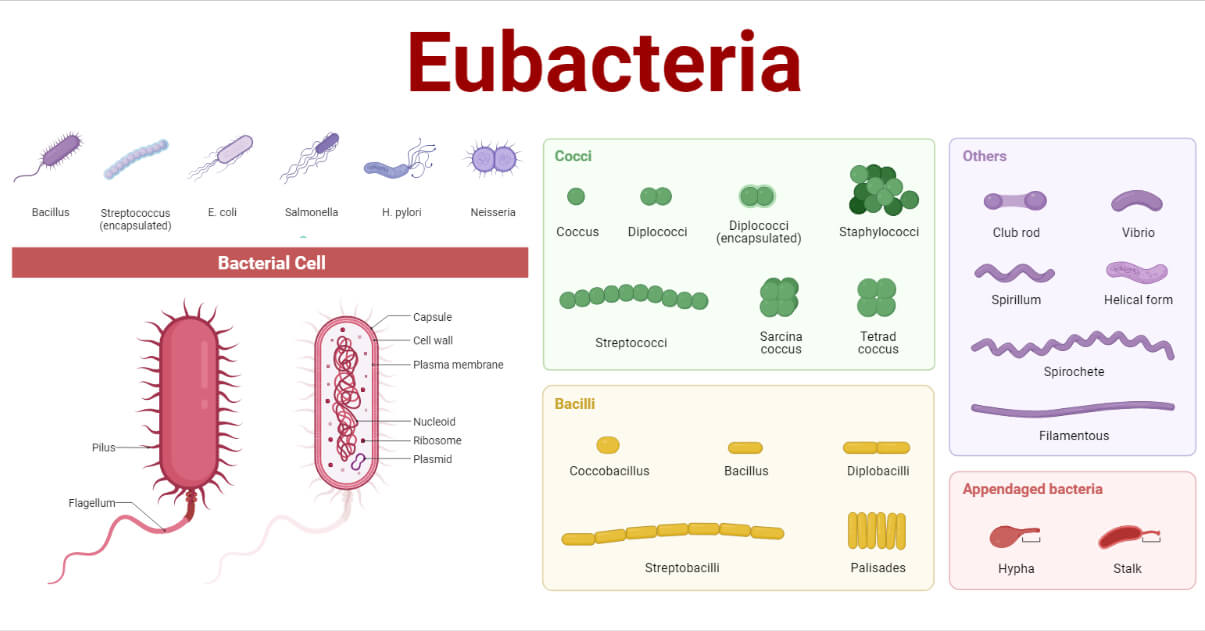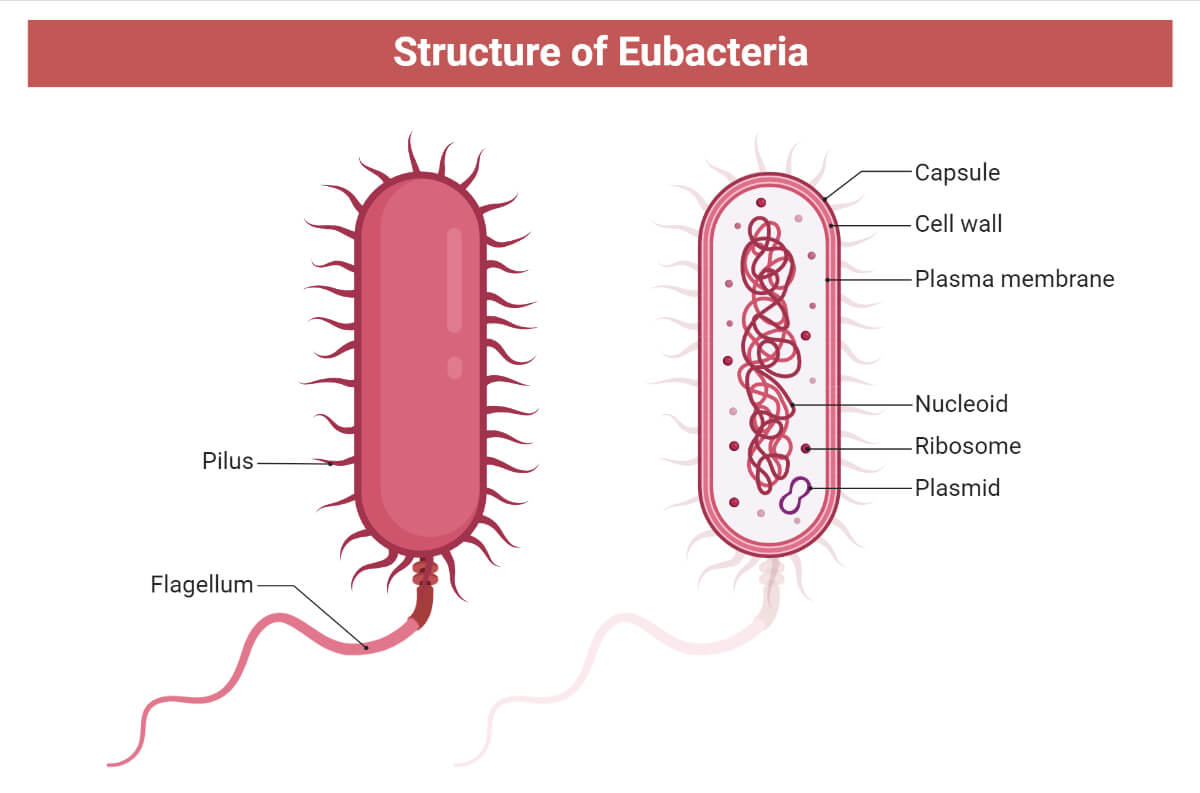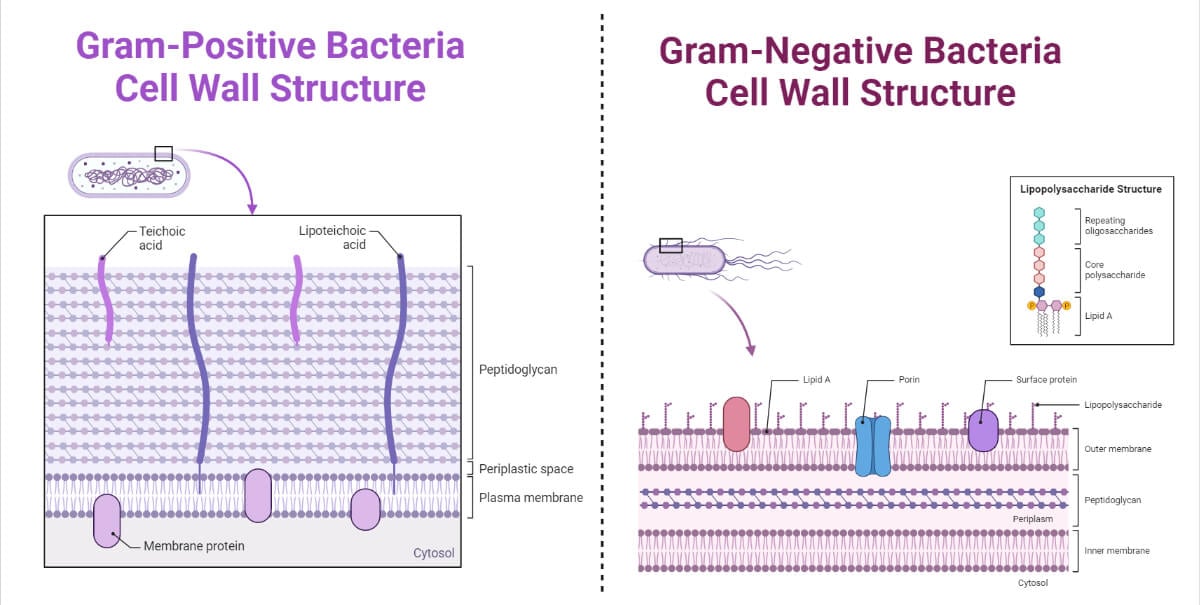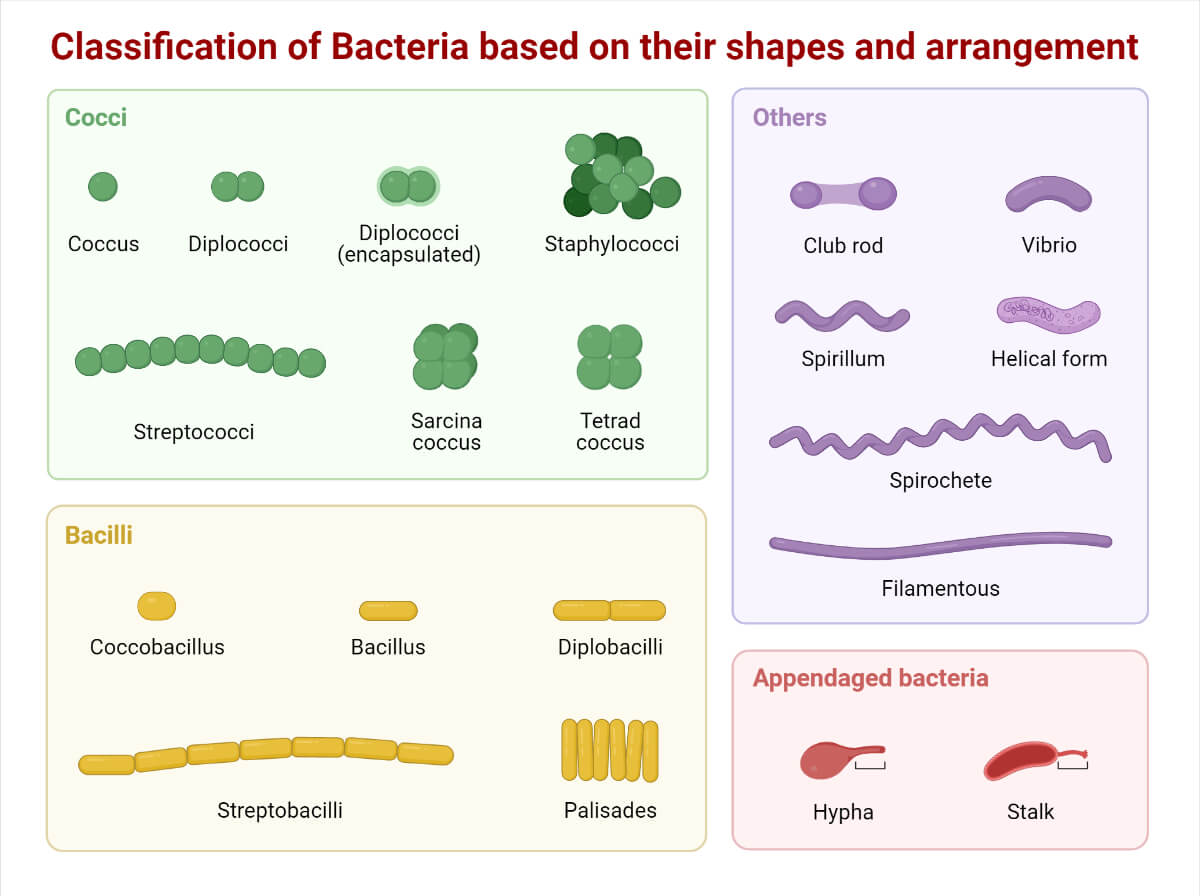Eubacteria is a large group of bacteria having rigid cell walls, flagella, DNA (single circular chromosome), and a single cell lacking a nucleus.

- All types of bacteria are included (Gram’s positive and negative) under the eubacteria except for archaebacteria.
- They are single-celled prokaryotic microorganisms, also known as true bacteria.
- They consist of a range of characteristics and are present in various conditions throughout the world.
- All living organisms are classified into three domains of life: Domain Archeae, Domain Eukaryota, and Domain Eubacteria.
- Eubacteria are a complex domain of the kingdom Monera.
Interesting Science Videos
Characteristics of Eubacteria
- They are unicellular, prokaryotic microorganisms; however, some bacterial colonies are found in filaments or aggregates in the form of surface biofilm.
- They have flagella, which helps in locomotion.
- Eubacteria reproduce by binary fission or by budding.
- Some of the eubacteria have pilli (small appendages on the cell’s surface, the function of pilli is to help in sexual reproduction).
- The cell wall is made up of peptidoglycan (murein) in a cross-linked chain pattern.
- A chromosome is single and circular, but some bacteria have two chromosomes (like vibrio cholera), while other species have a linear chromosome, and nucleosomes may be present.
- Eubacteria lack a membrane-bound nucleus.
- The size of the bacteria ranges from 0.2 to greater than 5 micrometers.
- Their cells consist of lipids, carbohydrates, protein, and nucleic acid.
- Depending upon the peptidoglycan in the cell wall and the gram stain they take, eubacteria are classified as gram-positive and gram-negative.
- The plasma membrane contains cytosol (fluid), which is primarily composed of water (80%), but it has a gel-like consistency due to the presence of dissolved nutrients, DNA, cytoskeletal elements DNA, and other substances.
- They have 70S-type ribosomes as organelles composed of RNA and protein that complete the process of translation.
- The shape of the eubacteria is different such as cocci, bacilli, rods, vibrio, filament, or spirochetes.
- Introns are absent in eubacteria.
- Exhibit both glycolysis and kerb’s cycle.
- They can produce spores to remain dormant in unfavorable conditions and may cause serious diseases.
Structure of Eubacteria
- Capsule
- A capsule surrounds some eubacterial cells, that are made up of polypeptides or polysaccharides.
- Capsule helps in causing disease in some bacteria, capsule protects bacteria from phagocytosis (example: pneumococcus).
- It acts as the site for the disposal of waste material, and another function of the capsule is the storage of food material.
- Cell wall
- The cell wall is made up of peptidoglycan. It is located beneath the capsule.
- The cell wall of eubacteria is rigid and gives characteristics, structure, or shape to the cell.
- The function of the cell wall is to protect the cell from high osmotic pressure differences.
- Flagella
- Flagella are long appendages that are composed of flagellin molecules.
- Flagella is responsible for the locomotion of bacteria, they move in a longitudinal wave-like action.
- Each bacteria may have flagella located at different positions and in different numbers (some have one, some have a few, and some have numerous) on the cell.

- Pilli or fimbriae
- Pilli arises from the cell membrane, it is a short, hair-like appendage that extends beyond the cell wall.
- They are made up of the protein pilin or fibrillin.
- Fimbriae help in attachment in the host and play an essential role during conjugation.
- Plasma membrane
- It is a semi-permeable lipid bilayer membrane. Lipids and proteins are the main components of the plasma membrane.
- From the plasma membrane, specific ions, molecules, nutrients, and water are transported across the membrane.
- Ribosome
- 70S ribosomes are present in the cytoplasm. They play an essential role in translation by translating the genetic message in mRNA into protein.
- Nucleoid
- It is the DNA of bacteria, usually called the chromosome. It consists of single circular chromosomes.
- Mesosome
- It is found in the form of tubules and vessels. The functions of mesosomes are to increase the surface area for transportation, carry the site of attachment for a single peptide, be involved in the control of autolytic enzyme activity, and help in septum formation during cell division.
Types of Eubacteria
Based on gram’s stain, bacteria are divided into two types;
- Gram’s positive:
- Gram’s positive bacteria have a thick cell wall and consist of a high amount (about 80%) of peptidoglycan.
- They retain blue or violet, or purple color in gram staining.
- The lipid content in gram-positive bacteria is low, so they are sensitive to lysozyme and antibiotics.
- Mesosomes are present.
- Examples: Azotobacter, Mycobacterium.

- Gram’s negative:
- The cell wall is thin and contains a low amount (about 20%) of peptidoglycan.
- They do not retain blue but retain the pink or red color of the safranin.
- The amount of lipid content is high because of the high lipid content. They can resist lysozyme and antibiotics.
- Mesosomes are generally absent.
- Example: Salmonella, E.coli.
Cyanobacteria
- It is a sub-group of eubacteria. They have prokaryotic cells.
- The cell wall comprises murein with some cellulose, hemicellulose, and pectin.
- Flagella are absent. They perform oxygenic photosynthesis.
- Some cyanobacteria consist of heterocysts (a special type of cell).
- Sex organs and motile reproduction bodies are absent.
Classification of Bacteria based on their shapes and arrangement
Coccus
Spherical or rounded or oval-shaped bacteria are called cocci. Based on the arrangement they are the following type;
Monococcus: They appear singly. Eg: Micrococcus
Diplococcus: They exist in pairs. Eg: Pneumonia
Tetracoccus: They exist in a group of four. Eg. Tetracoccus cechi
Chain arrangement: Streptococcus
Grapes-like arrangement: Staphylococcus sps

Bacillus or rod-shaped bacteria
Rods-like or elongated-shaped bacteria called bacilli. Very short rods that can sometimes almost be mistaken for cocci are known as Coccobacilli.
Monobacillus: They exist singly. E.g. Lactobacillus
Diplobacillus: Exist in pairs. E.g. Moraxella
Steptobacillus: Exist in chain, E.g. Streptobacillus
Helical bacteria
They are coiled or twisted bacteria. They are spiral (Spirochete) and vibrio (comma-shaped e.g. Vibrio cholera).
Evolution of Eubacteria
- The simplest bacteria and blue-green algae (cyanobacteria) have been classified as prokaryotic cells.
- These cells have no nuclear membrane by which the hereditary material (DNA) is set apart from the cytoplasmic bodies and lacks introns.
- Phylogenetically, the progenote evolved into three types of cells Archaebacteria, Eubacteria, and eukaryote.
- Molecular theories suggested that genes were transferred horizontally between the three types of cells, which consequently affected the evolutionary process of life.
- Endosymbiotic theory state that mitochondria and chloroplast were genetically transferred by gene transmission in the evolutionary process of some bacteria.
- Eubacteria include Cyanobacteria, Chloroxybacteria, Paracoccus, Non-sulphur bacteria, sulfur bacteria, green filamentous bacteria, green sulfur bacteria, Spirochetes, and Desulphovibrio.
Reproduction in Eubacteria
- Usually, eubacteria reproduce by asexual reproduction, such as binary fission and budding, dividing the parent cell into two daughter cells after the replication of genetic material. This process is known as binary fission.
- Spore-forming bacteria form spores in unfavorable conditions like deficiency of nutrients, exposure to radiation, chemical, and unfavorable temperature. These spores cannot reproduce, but they resist heat, chemicals, toxins, and dryness. When environmental conditions become favorable again, spores start to vegetate and reproduce.
- True sexual reproduction is absent, but sexuality is accomplished by conjugation, transformation, and transduction.
Mode of nutrition of Eubacteria
- Most of the eubacteria are heterotropic. Eubacteria cannot synthesize their food and consume it from other sources such as other plants, organic carbon sources, or animal matter. Heterotrophs decompose dead material or parasites that live in a host.
- Some of the eubacteria are autotrophs. They synthesize their food by either chemosynthetic or photosynthetic methods.
- The primary example of eubacteria is cyanobacteria.
Importance of Eubacteria
- Eubacteria increase soil fertility through nitrification, nitrogen-fixing process, and ammonification.
- Various species of eubacteria are used in the synthesis of vitamins. These vitamins are inexpensive, safe, and non-toxic. Example: Propionibacterium and pseudomonas spp produce vitamin B12.
- Some eubacteria are very useful in the pharmaceutical industry. Example: Streptomyces spp strain produces several types of antibiotics.
- Lactobacillus is used in the dairy industry.
- Used for the degradation of petroleum hydrocarbons.
- Eubacteria help in the decomposition of the dead organism.
- Some eubacteria are used for insect control.
- Eubacteria habitat in the human body, forming normal flora. Normal flora is beneficial to our bodies. They defend our bodies against pathogenic bacteria, and some produce vitamins B and K, which benefit the body.
Difference between Eubacteria and Archaebacteria
| Eubacteria | Archaebacteria |
| They are complex organisms found anywhere on earth. | They are simpler than eubacteria and generally present or live in extreme conditions. |
| The cell wall is made up of peptidoglycan. | The cell wall is made up of pseudopeptodoglycan. |
| Energy is obtained from the Krebs cycle or glycolysis. | They cannot perform glycolysis and the Kerbs cycle. |
| RNA polymerase is simple. | RNA polymerase is complex. |
| Introns are absent. | Introns are present. |
| Contains L-glycerol phosphate in their membranes lipids. | Contains D-glycerol phosphate in their membrane lipids. |
| Examples: Bacillus, Mycobacterium, Clostridium | Examples: Ferroplasma, Thermoproteus, Halobacterium |
References
- Verma, P. S., & Agrawal, V. K. (2006). Cell Biology, Genetics, Molecular Biology, Evolution & Ecology (1 ed.). S . Chand and Company Ltd.
- Whitfield, C., Szymanski, C. M., Lewis, A. L., & Aebi, M. (2022). Eubacteria. Essentials of Glycobiology [Internet]. 4th edition.
- https://www.researchgate.net/publication/316617126_Difference_Between_Archaebacteria_and_Eubacteria.
- https://www.biologyonline.com/dictionary/eubacteria.
- http://www.biology.lifeeasy.org/2256/what-is-the-cell-structure-of-eubacteria.
- https://collegedunia.com/exams/eubacteria-types-characteristics-mode-of-nutrition-biology-articleid-2934.
